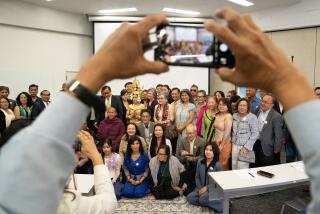Cambodia Factions Hold Their First Meeting at Home : Southeast Asia: Khmer Rouge leader returns for council session. Troops guard capital to prevent violence.
PHNOM PENH, Cambodia â With the titular leader of the detested Khmer Rouge guerrillas returning at the last minute to Phnom Penh, the four factions in Cambodiaâs civil war Monday achieved a symbolic breakthrough by holding their first-ever meeting on Cambodian soil.
Heavily armed troops and police were deployed throughout the capital to prevent another outbreak of the public demonstrations that have repeatedly blocked the Supreme National Council, a 12-member consultative body, from convening its first session on home territory.
Prince Norodom Sihanouk, who heads the council, summoned the four factions to the meeting late last week to breathe new life into the peace process, which has showed signs of faltering since the signing in Paris in October of a 19-nation settlement of the 20-year civil war.
The meeting became possible with the arrival early Monday of Khieu Samphan, a French-trained economist who officially heads the Khmer Rouge leadership.
In a surprise development, he was not accompanied as expected by Son Sen, the Khmer Rouge defense chief who holds the organizationâs second council seat. There was no explanation for Son Senâs absence, but council rules require only 10 members be present, including one from each faction.
Traffic was blocked throughout the capital as Khieu Samphan sped through the streets in a black limousine. He drove directly to Sihanoukâs royal palace for the meeting. âThere was a very, very good spirit,â said Chan Youran, the Khmer Rougeâs ambassador to Beijing, after the meeting broke up.
Sihanouk, who normally courts publicity, refused to see the press both before and after the meeting.
Shortly after he returned for the first time last month, Khieu Samphan was attacked by a mob. The protesters sacked the Khmer Rouge residence in Phnom Penh, and Khieu Samphan narrowly escaped being lynched. Bleeding profusely from a head wound, he escaped to the airport and was flown to Bangkok.
More than 1 million Cambodians died of starvation, torture and execution during the Khmer Rouge reign in Cambodia from 1975 to early 1979. The group was ousted by an invasion from Vietnam and fled to Thailand, where it formed an opposition coalition with Sihanouk and another non-Communist force.
An attempt to convene a council meeting last week also failed because of instability that followed days of violent demonstrations in Phnom Penh against corruption in the Phnom Penh regime. Government officials have become enriched in recent months by selling state property and pocketing the proceeds. Prime Minister Hun Sen took the unusual step of dismissing a minister and two deputies last week and enacted a tough law prohibiting demonstrations without official approval. A 10 p.m. to dawn curfew also was adopted.
Mondayâs council meeting was witnessed by representatives of the United Nations and diplomats from the permanent five Security Council members, which have been instrumental in drawing up a Cambodia peace plan. They are the United States, China, Britain, France and, for the last few days, Russia.
Diplomats said the council drafted a letter appealing to the United Nations to speedily deploy troops of the U.N. Transitional Authority for Cambodia and to appoint a U.N. special representative for Cambodia. They also called for the United Nations to clear land mines from the country and repatriate refugees from Thailand before the rainy season starts in April.
The October peace agreement calls for the United Nations to monitor Cambodiaâs cease-fire and to take over the running of key ministries in the interim period leading up to free elections in 1993.
But the precise formation of the U.N. force has been delayed at the United Nations while experts study how many troops will be required and how the world body will pay for the mission.
Some estimates have suggested that as many as 10,000 troops will be involved, the largest peacekeeping operation in U.N. history. U.N. peacekeeping duties now are being carried out by a skeleton force of Australian and French troops.
While the council meeting handled essentially routine business Monday, a diplomat said the session is important âsymbolically and psychologicallyâ because the four factions could overcome past hurdles and hold the meeting in Cambodia. âFrom now on it will be easier and easier for the (council) to hold their meetings here,â the diplomat said.
After the meeting was over, Khieu Samphan retired to the council headquarters building in Phnom Penh, a grand edifice that once housed Pol Pot, the dreaded leader of the Khmer Rouge. Pol Pot was ousted by the Vietnamese invasion in January, 1979.
Under an agreement negotiated in the Thai beach resort of Pattaya early this month, the Phnom Penh regime agreed to allow Khmer Rouge leaders to live in the council building to ensure their safety while in the Cambodian capital.
More to Read
Sign up for Essential California
The most important California stories and recommendations in your inbox every morning.
You may occasionally receive promotional content from the Los Angeles Times.










